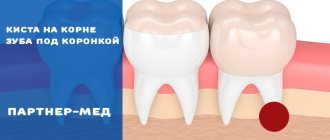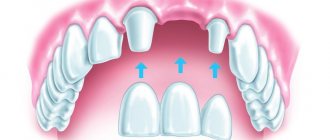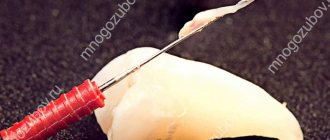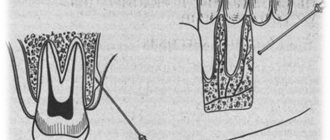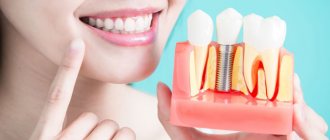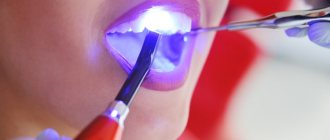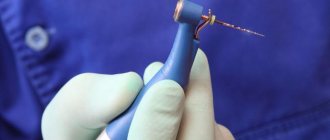243
The impeccable functioning of the human dentofacial apparatus is possible only with the complete integrity of the jaw rows.
The absence of even one element triggers a process of negative morphological and functional changes, which become increasingly worse over time.
These changes can be prevented only through timely prosthetics of the defect. Delaying it can lead to serious consequences, information about which is brought to your attention in the article below.
General concept
The Popov-Godon phenomenon (P-G) is a pathological restructuring of the dentoalveolar processes due to tooth loss or, in other words, a violation of the integrity of the rows.
The pathology got its name from the dentists who first described it. Namely, the Russian scientist O.V. Popov, who observed in 1880 the deformation of the dentition of a guinea pig, whose incisors were removed, and Godon, who in 1904 described the deformations of the dentofacial apparatus of patients after the loss of elements of the jaw rows.
In addition, Godon is also known for proposing his hypothesis to explain the development of the phenomenon, which he called the theory of articular equilibrium.
The clinical picture of the P-G phenomenon is varied. One of the most easily recognizable manifestations of pathology is the vertical extension of the unit located opposite the defect from the alveolar process, its crown crossing the occlusal plane and entering the space of the defect.
In some cases, advancement continues until full contact with the surface of the gum of the opposite row. Units that are located next to the defect can tilt towards it, rotate around their axis, and shift in one direction or another.
The relationship between different types of pathological displacements in the Popov-Godon phenomenon made it possible to establish a study conducted on 120 young patients who had anomalies caused by adentia.
It turned out that medial displacement accounts for 45.1%, combined - 17.5%, palato-oral - 10%, distal - 9.5%, vertical - 9.5% described above, vestibular - 5 .5%, for tortoposition (rotation around an axis) – 2.2%.
In addition to visual, clearly visible manifestations of pathology, there are also hidden or less visible ones. They are expressed by a violation of the occlusal relationships of individual units, deformation of the occlusal plane, dentoalveolar enlargement and some other features.
The specific form of manifestation of the P-G phenomenon depends on a number of factors:
- Length and location of the defect.
- Time elapsed since tooth loss.
- Age of the patient (negative manifestations occur faster in children).
- General health.
- Conditions and characteristics of the jaw apparatus.
Delay in treating the P-G phenomenon threatens the patient with many negative consequences:
- Chewing dysfunction.
- Deterioration of smile aesthetics.
- Chronic articulation injury, fraught with the risk of malignancy.
- Blocking low frequencies.
- TMJ dysfunction due to overload.
- Impaired articulation and diction.
- Pain and discomfort in some clinical situations.
- Deterioration of treatment and prosthetic conditions.
The root cause of the Popov-Godon phenomenon is tooth loss, which can occur for various reasons - due to caries, periodontitis and other diseases, injuries, forced extractions.
As a secondary cause of displacement during edentia, one should consider the restructuring of the dentoalveolar process according to mechanisms that are still not completely understood.
There are different theories explaining this process. In particular, Hodon’s theory, mentioned above, is that the jaw apparatus is a system that maintains immobility with the integrity of the rows due to a closed chain of forces.
If at least one tooth is lost, the closed chain breaks, which causes multidirectional displacement.
There are other theories that explain the P-G phenomenon, but there is still no one that would be recognized by all experts.
Let's talk about the impact of bite on the face and the possibilities to correct the situation.
Come here if you are interested in the connection between bite and headaches.
At this address https://orto-info.ru/zubocheliustnye-anomalii/okklyuzii/ispravleniya-prikusa-viniryi-v-stomatologii.html find out whether veneers correct the bite.
General information
Dental pathology is not a serious disorder, but in the absence of proper treatment it can provoke some complications. The main reason for its development is considered to be the loss of teeth without subsequent implantation or prosthetics. According to research, more than 30% of patients who have had at least one tooth removed do not think about the implantation procedure.
This is how the phenomenon manifests itself when a tooth is lost
This is due to the fact that with such a minimal loss, the process of chewing food is not disrupted, so a person does not rush to the dentist. It is noted that 2-3 months after the removal of one or more units, a gradual displacement of healthy teeth begins. If a person does not visit a specialist for a year to install implants, the procedure will be quite problematic.
When one tooth is removed, the pathology develops quite slowly. If the number increases, rapid displacement of healthy teeth begins, elongation of the alveolar processes and other disorders:
- dysfunction of the muscles of the lower jaw;
- advancement of the upper or lower dentition;
- changes in the structure of the alveolar processes;
- exposure of the root of healthy units located directly next to the void;
- formation of a gum pocket around healthy teeth;
- dysfunction of the temporomandibular apparatus;
- narrowing of the periodontal fissure;
- changes in collagen fibers;
- dystrophic processes in the pulp;
- disturbance in the structure of the periodontium.
As a rule, several months or even years after the removal of one or several units, prosthetics and implantation become very complicated. It is for this reason that experts strongly recommend making a replacement no later than 10-14 days after extraction.
Classification and symptoms
The anomaly can lead to various types of movement, which seriously complicates the diagnosis of the pathology. The following types of movements are noted:
- Vertical – one-sided, two-sided, unidirectional, mutual. This type of movement is typical for both lateral and frontal units. A displaced unit can completely occupy the defect space, thereby blocking the horizontal movement of the NP.
- Tilts in the distal and medial direction - towards the defect.
- Tilts in the buccal and lingual-palatal direction.
- Rotation around a long axis.
- Combined offset.
- Dentoalveolar elongation.
The classification according to Ilina-Markosyan and Ponomareva provides for the division of the P-G phenomenon into two forms:
- 1st. It is characterized by dentoalveolar elongation while maintaining the ratio of the intra- and extra-alveolar parts of the tooth. There are no gum pockets, the neck is not exposed, periodontal resorption is absent or insignificant - no more than ¼.
- 2nd. The dentoalveolar elongation is approximately the same size as in the first form, but with exposure of the neck. Periodontal resorption is at least half. The extra-alveolar part of the tooth is enlarged in relation to the intra-alveolar part.
At its core, the second form is a more developed first. Therefore, the difference between the forms is rather arbitrary.
Diagnostic measures
The Popov-Godon phenomenon is diagnosed by examination, radiography (orthopantomography, teleradiography), and the study of diagnostic models. The latter must be made before treatment, during and after correction.
The following signs support the presence of the syndrome:
- Partial edentia.
- Distortion of the occlusal curve (there is a supra- or infraocclusal position in relation to the occlusal plane).
It is established on the basis of a teleroentgenogram and/or orthopantomogram (they draw the occlusal plane and see whether the crowns intersect it or not). - Dental alveolar enlargement in the area of displaced units.
- Absence of dentoalveolar reduction.
- Reduced distance between the chewing surface of the advanced units and the gingival mucosa of the opposite row. With severe pathology, the gap between them may be completely absent, creating a risk of injury to the mucosa.
- Periodontal resorption of varying degrees in the area of moved units (but it may be absent in the first form).
- Invariance of periodontal tissues, dentin and enamel.
One of the main diagnostic results is the statement of the fact that the displaced teeth intersect the occlusal plane. This is important for differential diagnosis.
In some pathologies that can be mistaken for the Popov-Godon phenomenon (for example, with pathological abrasion of chewing/cutting surfaces), the teeth do not intersect the occlusal plane.
Correction methods
Before prosthetics of the defect that caused the anomaly, the following correction methods are taken:
- Orthodontic (hardware) – disocclusion method.
- Hardware-surgical.
- Therapeutic – grinding off part of the crown.
- Surgical.
The main goal of treatment before prosthetics is to align the occlusal plane in the area of displaced teeth. The orthodontic method of correction is considered the main and preferred method.
Disocclusion method
Disocclusion is an orthodontic hardware method of correction.
Its essence lies in the fact that with the help of removable and non-removable orthodontic devices, mouth guards or temporary bridges, the bite and inclined platforms of the devices apply vertical and/or horizontal pressure, returning the displaced units to the correct original position.
In this case, the bite pad, resting against the extended units, separates the remaining intact teeth by approximately 2 mm. This distance corresponds to the gap between the occlusal surfaces of the rows when the jaws are inactive.
The pressure of the bite pad on the extended teeth leads to their intrusion (deepening into the gum) - until the moment of closure of all intact units.
If 2 mm is not enough for this, the bite pad is thickened with self-polymerizing plastic by another 1-2 mm. And so on until the chewing surfaces of all teeth are in the occlusal plane.
If horizontal displacement is necessary, braces, aligners with inclined platforms, or other orthodontic devices with traction are used.
The disocclusion method leads to dentoalveolar reduction in the area of the protruding elements, and does not affect the height of their clinical crowns. It is used for the 1st form of pathology in patients no older than 40-45 years. After successful correction of the defective areas, a permanent bridge is made.
Hardware-surgical therapy
If within 3-4 weeks the disocclusion method does not lead to success due to the lack of restructuring in the dentoalveolar process, a hardware-surgical technique is used.
It consists in the fact that before using the disocclusion method, the bone of the alveolar process in the area adjacent to the corrected unit is subjected to compactosteotomy - thinning by drilling many holes.
As a result, the compact bone acquires plasticity and is easily rebuilt under the action of the apparatus used for disocclusion according to the method described above.
Grinding method
Grinding off the part of the tooth that has moved beyond the occlusal plane is, although the simplest, but also the least physiological solution. It is used for the 2nd form of the phenomenon in patients over 35-40 years old, in relation to those units that cannot be corrected by the disocclusion method.
Before deciding on grinding, it is determined from an x-ray or a diagnostic model what size part of the crown has crossed the occlusal plane. If it is insignificant, within the thickness of the enamel or a little more, then the crown is ground off without depulpation.
If during grinding there is a risk of touching the pulp horn, first depulpation is carried out, and only then grinding.
After minor grinding, before prosthetic repair of the defect, remineralization of the polished area is carried out. If it was necessary to remove a layer of dentin, an artificial crown is installed on the tooth, which can be an independent prosthesis or part of an MVP installed over the entire defect.
Surgical intervention
The surgical method consists of removing displaced teeth. It is used for the 2nd form of the syndrome, when treatment with disocclusion or grinding is considered inappropriate.
This happens with significant deformation of the occlusal plane, significant mobility of the teeth, serious chronic processes in the apex and periodontium of the displaced units, as well as with hypertrophy of the alveolar ridge.
Along with extirpation, if necessary, partial resection of the alveolar ridge can be performed. As with other correction methods, the defect after tooth extraction is subject to prosthetics.
Let's figure out how bite affects the spine and where to start treatment.
This publication contains all the most important things about biprognathic occlusion.
Here https://orto-info.ru/zubocheliustnye-anomalii/okklyuzii/starcheskaya-progeniya.html find out what senile progeny is.
Diagnostics
Detection of pathology begins with a visual examination of the oral cavity. The doctor carefully examines the jaw arches, assessing their condition. Using the classification of the phenomenon, it is determined at what stage the disease is.
To clarify the diagnosis, an x-ray may be prescribed. In the resulting images, the distances between the elements of the jaw row are carefully studied. The distance in both frontal and lateral projection is important.
The question of the development of pathology is raised only when a displacement of the elements of the central region is detected. If there are clinical signs of the phenomenon, but there are no changes in the central zone, adentia is suspected.
Only after clarifying the diagnosis, the doctor prescribes treatment. The therapy methods and technologies used are individual for each clinical case.
Differential diagnosis is carried out to distinguish pathology from adentia (dental disease, the main symptom of which is the complete or partial absence of teeth).
Let's figure out together how the bite affects the spine and vice versa.
In this publication we will look at the signs of biprognathic occlusion.
Here https://zubovv.ru/ortodontiya/prikus/pochemu-pryamoy-pogranichnomu.html find out how to correct a straight bite.
Preventive measures
The main preventive measure to prevent the Popov-Godon phenomenon is to maintain the integrity of the rows. If this cannot be achieved, the lost teeth must be replaced with dentures.
Tooth loss can be avoided by high-quality oral care, giving up bad habits, timely treatment of all dental diseases, using protective mouthguards when playing contact sports, and preventive visits to the dentist.
The video provides additional information on the topic of the article.
Reviews
Adentia, complicated by the Popov-Godon phenomenon, is a serious pathology that requires time and money to treat.
If you have personally encountered this problem, tell us how you managed to overcome it. What treatment method was used? How effective was it? You can leave a comment at the bottom of this page.
If you find an error, please select a piece of text and press Ctrl+Enter.
Tags: bite correction
Did you like the article? stay tuned
Previous article
Relevance of neuromuscular dentistry
Next article
Etiology of retrognathia and its progressive treatment
